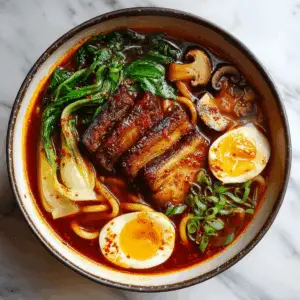
Pork Belly Udon Soup with Gochujang Chili Paste
Equipment
- Large pot To simmer the broth and bring the flavors together. A Dutch oven works great for heat retention.
- Frying pan or skillet For searing and rendering the pork belly slices.
- Strainer or sieve Useful if you're making your own dashi or want to strain out any miso clumps.
- Tongs For handling the pork belly and noodles easily.
- Ladle To serve the soup without disturbing the beautiful layers.
- Chopsticks or noodle tongs To portion out the noodles effectively.
Ingredients
For the Pork Belly
- 1 lb pork belly skin-on and cut into 1-inch thick slices
- 1 tablespoon soy sauce
- 1 tablespoon mirin
- 1 tablespoon sake
- 1 teaspoon sesame oil
- 1/2 teaspoon freshly ground black pepper
For the Broth
- 6 cups dashi stock can be homemade or store-bought
- 2 tablespoons white miso paste or red miso for a stronger flavor
- 1 tablespoon gochujang Korean chili paste
- 1 tablespoon soy sauce
- 1 teaspoon fish sauce
- 1 tablespoon mirin
- 1/2 teaspoon sugar
- 1 teaspoon grated ginger
- 2 cloves garlic minced
For the Soup
- 2 packs fresh or frozen udon noodles or substitute dried if needed
- 1/2 cup shiitake mushrooms sliced
- 1/2 cup enoki mushrooms trimmed
- 2 baby bok choy halved lengthwise
- 2 scallions sliced thin
- 1 soft-boiled egg per serving optional, but highly recommended
- Sesame seeds and chili oil for garnish optional
Instructions
Prep the Pork Belly
- Season your pork belly slices with soy sauce, mirin, sake, sesame oil, and black pepper. Let them marinate for at least 15 minutes while you prep the rest of the ingredients.
Render and Sear
- Heat a frying pan over medium heat and place the pork belly slices skin-side down. Let the fat render slowly until the skin is crispy and golden. Flip and sear the other side. Once both sides are caramelized, remove and set aside. Don’t discard the fat — you can use a tablespoon to enrich the broth if desired.
Build the Broth
- In a large pot, add your dashi stock and bring to a simmer. Stir in the miso paste until fully dissolved, followed by gochujang, soy sauce, mirin, fish sauce, sugar, ginger, and garlic. Let it gently simmer for 20-25 minutes to allow the flavors to meld. If you prefer a more creamy udon base, stir in a splash of unsweetened soy milk or a spoonful of tahini.
Cook the Udon Noodles
- While the broth simmers, cook your udon noodles according to package instructions. If using frozen noodles (which are often preferred for texture), boil them just until loosened, then drain and rinse under cold water to stop the cooking. This keeps them springy and chewy — a hallmark of a good japanese udon noodle recipe.
Blanch the Vegetables
- In the same pot or separately, quickly blanch the bok choy and mushrooms for 1-2 minutes until tender but still vibrant. Set aside for assembly.
Assemble the Bowls
- Divide the cooked udon noodles between 4 large bowls. Ladle over the hot miso-gochujang broth. Top with seared pork belly, bok choy, mushrooms, and soft-boiled egg. Finish with scallions, a sprinkle of sesame seeds, and a drizzle of chili oil if you like extra heat.